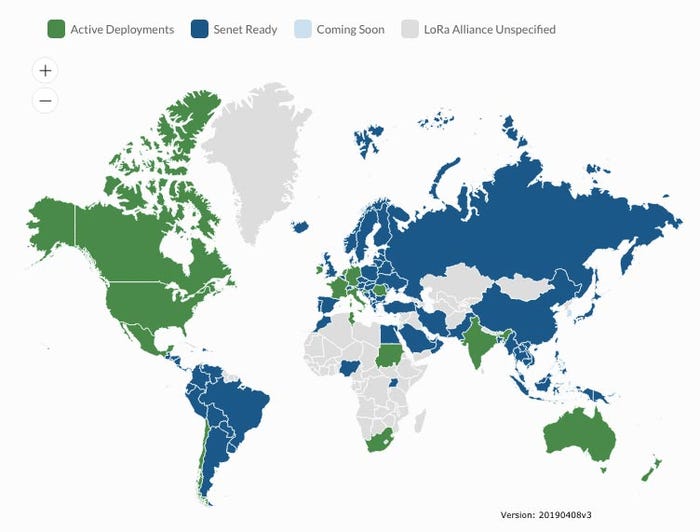The first firm to get FCC certification for LoRaWAN sensors and gateways is finding growing traction for an array of applications.
April 25, 2019

“Senet” is the name of an Ancient Egyptian board game dating back to at least 3,000 B.C., which eventually gave rise to backgammon. The company Senet, however, which is a finalist in the IoT World Awards, derives its name from its description of being a “Sensible Network Company.”
Founded roughly a decade ago as “EnerTrac,” the company’s initial focus was on using an end-to-end IoT technology to optimize propane delivery. EnerTrac outfitted the white propane tanks sitting prominently alongside homes and businesses with sensors and built the first Long Range Wide Area Network (LoRaWAN) in the United States to transfer information about those tanks to fuel distributors.
“When you send a truck out to go fill up one of these propane tanks, the most profitable visit is when that tank is 80% empty,” said Senet Chief Executive Officer Bruce Chatterley. “Through our service, we were able to allow these fuel distributors to consistently hit that mark on all of their deliveries, which then translated into dramatically improved profitability.”
[Internet of Things World is the intersection of industries and IoT innovation. Book your conference pass and save $350, get a free expo pass or see the IoT architecture speakers at the event.]
The technology allowed fuel distributors to eliminate “truck rolls” and eventually shed trucks from their fleet, while also prioritizing their routes. “From the customer side, they also eliminated in some cases, hundreds of thousands of calls a year to their call center with what they call ‘tank anxiety,’” Chatterley said. “Because the technology enables the information to be delivered through a smartphone or web app, consumers know exactly how much is left in their propane tank and when a truck is coming out to fill it.”
Through the process of building out the service for fuel distributors, Senet also created a unique infrastructure. “At the time, there was no ecosystem for LoRa. And so we built our own sensors and LoRa gateways,” Chatterley explained. “And then we built our own cloud based services to manage everything — the sensors, gateways and the entire network.” The company also provided an application to transform the data streamed from propane sensors into actionable information for fuel distributors, becoming the first firm to get FCC-certification for LoRaWAN sensors and gateways. “We were the first LoRaWAN operator in the world with a public network,” Chatterley said.
Each time the company struck a deal with a fuel distributor, it built a regional network to cover their customers’ tanks.
In 2014, the company’s management (Chatterley joined three years later) assessed its operations across the United States and was struck by how expansive the network had become. The executives decided to form Senet as an umbrella company charged with expanding the applications of its LoRa network. By late 2017, the company sold off its EnerTrac Tank Monitoring technology to Independent Technologies, Inc., one of the largest tank-monitoring companies in the world. It maintains exclusive rights to build LoRaWAN infrastructure for that company across the world.
Since the private company’s growth has been “explosive,” Chatterley said. “We are more than doubling our business this year, and plan to more than double our business next year also, and we’re on track to do that.”
Research from IHS Markit projected the broader low power wide area market — encompassing LoRa, LTE-M1, NB-IoT and the French firm Sigfox’s proprietary technology — will grow at a compound annual growth rate of 89.3% from 2016 to 2021. IHS Markit further projected annual shipments of LoRa modules would grow at a rate of 92.3% from 2017 to 2021.

Senet’s most-recent network coverage map.
Senet’s network now extends across North America, South America and Australia while covering the majority of nations spread across Eurasia.
After joining, however, Chatterley realized that just expanding the network in itself would not necessarily create more business by itself. “It is not an ‘If you build it, they will come’ sort of thing,” he said. “This LPWAN businesses is what I call a ‘nook-and-cranny industry,’ meaning that everyone who comes to us with a need for connectivity really needs it in either unique geographies, or in a way that allows the technology to penetrate into unique places, like pits on the sides of buildings for water meters or in basements or in alleyways.”
The company has thus developed a business model designed to facilitate on-demand deployment of LPWAN networks where and when they are needed, and at an affordable price. “We shifted our business from a public network operator focus of building networks to building cloud-based software and services for the on-demand deployment of these networks,” Chatterley said.
Over time, the applications the company’s technology supports has extended far beyond propane tank monitoring. Those applications range from monitoring cryogenic gases in an industrial environment or hospital environment to monitoring CO2 tanks used to carbonate beverages at restaurants.
“One really explosive area of growth for us is in the utility space, in particular, water utilities,” Chatterley said. “We have proposed designs for networks for over 60 cities across the United States representing over 2 million potential in water meters,” he explained. “And that’s all happened in the last seven to eight months. And we continue to do probably two to three a week. We just deployed to a large city in California last week.”
Installing LoRaWAN networks for water metering applications requires a dense network to penetrate down to the often subterranean water meters located alongside houses. “That umbrella network then becomes the platform for a smart city set of applications for that metropolitan area,” Chatterley said. After the network is built and funded with an initial application, it provides infrastructure for smart city projects including smart trash, pest control and asset tracking. “Pretty much anything you can think can now work,” Chatterley said.
About the Author(s)
You May Also Like
.jpeg?width=700&auto=webp&quality=80&disable=upscale)
.png?width=700&auto=webp&quality=80&disable=upscale)



.png?width=300&auto=webp&quality=80&disable=upscale)
